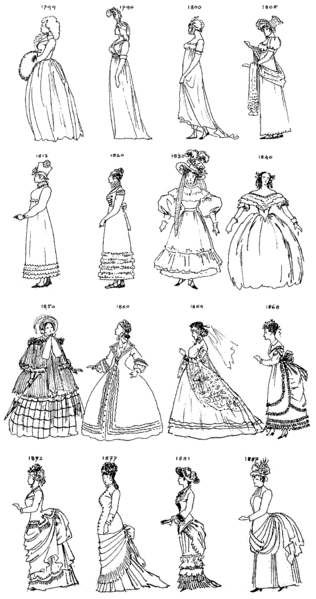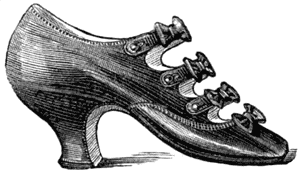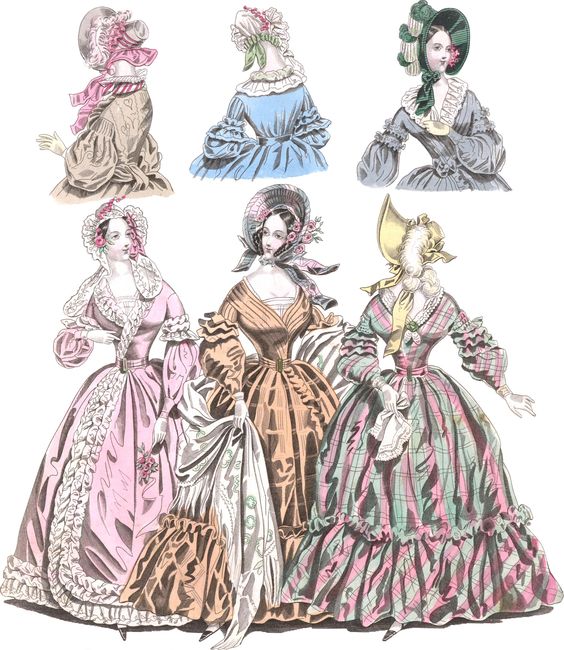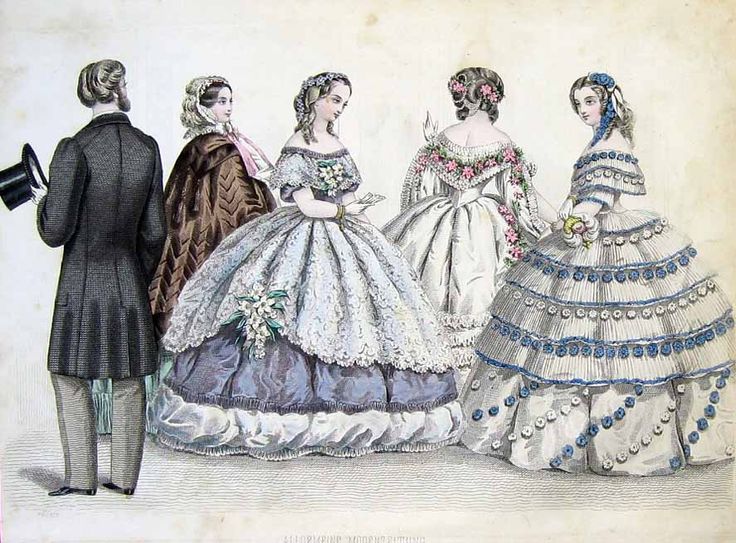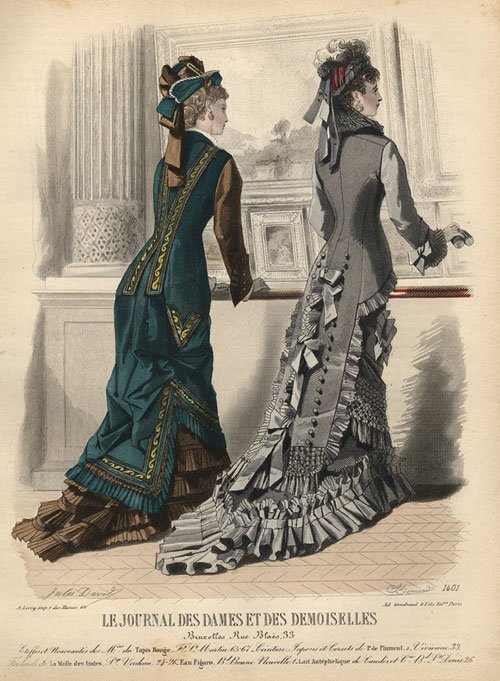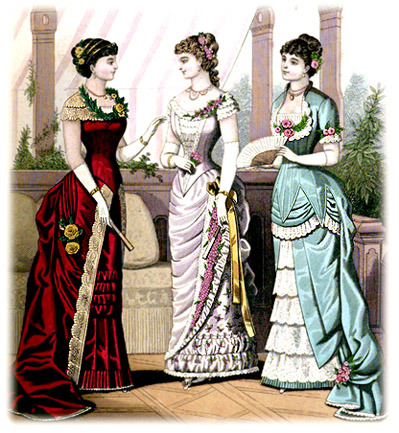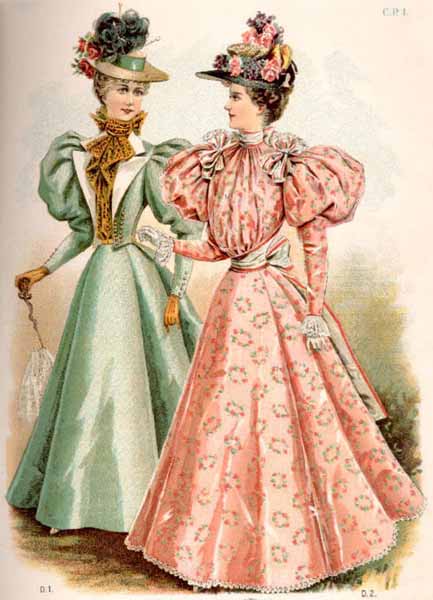Victorian fashion continues to be very iconic and well known. While the United States was at unrest because of slavery for much of it, the British lived peacefully under the rule of Queen Victoria. Many pieces such as the crinoline, corset, and bustle were very popular for ladies gowns. Over the course of about sixty years from the 1830s to the 1900s (decade, not year), fashion was constantly evolving, especially in Europe, Great Britain specifically.
For women, the dresses and gowns they donned displayed their social status and class. The wealthiest of women would wear tight corsets and extravagantly decorated skirts with many under layers. Most middle class women dressed very similarly, though their gowns were not as extravagant and had less decorations and adornments. Because of the many layers, it was uncomfortable and hard to move wearing the gowns Victorian women did. However, the lower class and poor did not have the chance to wear the extravagant gowns of the upper and middle class. Because they did not have much money, their gowns would often be old, out of style, simple, and made with much more inexpensive fabrics and not the luxurious cloth of the upper class.
The Bertha neckline was very popular during the Victorian Era. This style of neckline was below the shoulders, often trimmed with three to six inches of lace or other decorative material. It was socially unacceptable for working and lower class women to expose that much skin, so this style of neckline was only worn by the upper and middle class. With the Bertha neckline style very popular, straps were taken off corsets. Each gown with a neckline like this had to have two bodices: one for evening wear with décolleté and one for day use with a closed décolletage. Shawls were made essential with the décollecté style was introduced. Sleeves were very tight, limiting arm movement as fashion progressed and sleeves became even tighter. Once crinolines became more popular, sleeves began to have an appearance more so of a large bell to give a heavier volume to the gown. Under the sleeves were engageantes made of lace, linen, or lawn and made easy to remove. Often times engageantes could be seen under the large bell shaped sleeves on day dresses.
Corsets were very popular. They were used to give emphasis to small waists on a women’s body. Women would tie them very tightly to make their waists look as small as possible. Corsets could also help with keeping their posture upright and to prevent creases in gowns. However, corsets were later proved to cause a number of diseases and problems, so over time people began to oppose and stop wearing them. Corsets were laced tightly also for the purpose of a silhouette, which also changed over time. Wide skirts were used with crinolines and six or more layers of petticoats but evolved into the cage crinoline and then the bustle. As a matter of fact, crinolines were a problem because they could catch on fire, get caught in machines, etc. and caused many deaths.
Today, we think of hats from the Victorian times as very large and decorated with feathers, flowers, and other items. Hats like these were not popular until the end of the era. Like the style of dresses worn, hats evolved throughout time. In early Victorian times, hats made in a modest size were worn with designs that did not distract from the voluminous hoop skirts and crinolines. Bonnets made of straw and fabric were popular because they added to the look without taking attention away from the actual dress. But by the end of the period, large wide-brimmed hats were worn to go with the silhouettes of the time. Instead of very simple designs, they had flowers, ribbons, exotic plumes, and all sorts of decorations. It was not uncommon to see a woman even wearing a hat with a small stuffed bird on it! Plumes came from birds from the Florida everglades though, and many environmentalists were trying to stop the trend. Over five million birds annually were killed for the sheer purpose of decoration by 1900.
Many types of shoes were worn. A magazine in the 1870s once described feet as being a way to determine a woman’s position socially. Women with small feet that looked pretty when walking indicted she was of high standing. Making feet look appear as small as possible was very common and desirable, such that many women would even squeeze their feet into shoes two sizes smaller. Walking shoes were styled with embroidered stockings. On the front were straps that fastened with buttons and a bow on the toe. The Oriental Shoe was a small heeled show that had three straps that each had a bow on them. Black Satin Boots were mainly worn indoors and laced on the side and fastened in the front. Straps showed fancy stockings worn beneath the shoes. Kid Walking boots had laces on the side with colored embroidery on the front while the Carriage Boot was made of kid and quilted satin. Ladies’ riding boots were worn for horseback riding and had cord and tassels decorating them. High-heeled Walking Shoes were worn daily. Sometimes they would not have any straps in front, and other times there would be one. Often times they had lots of embroidery and were adorned with bows. At home various types of slippers for different tasks were used.
In Mourning periods, black was always worn like it is today. It all depended on the relationship to the deceased though as to how long you were in mourning and it was acceptable to be donned in mourning black. Only black was worn during First Mourning. First Mourning also had many restrictions as to what fabrics, collars, et.c were on gowns and clothing. Afterwards, mourners would wear less black for Second Mourning then came Ordinary Mourning and Half-mourning. By the time Half-mourning was reached, colors like mauve or lavender were worn instead of black. Not everyone went through these four stages though, as it depended on their relationship.
Queen Victoria’s reign began in 1837, marking the true beginning of the Victorian Era. At the time, a woman’s “ideal shape” was a long and slim torso with wide hips for emphasis. Corsets were laced as tightly as possible and extended down the abdomen to the hips. Underneath the corsets chemises were worn and also helped to prevent exposure. Above the corset a women wore a tight fit bodice with a low waistline for a long skirt with layers upon layers of horsehair petticoats beneath it. Petticoats were worn to give the skirt a fuller look. Necklines were low and straight to contrast the narrow waist corsets provided.
During the 1840s, lower necklines, V shaped bodices that were more elongated, collapsed sleeves, and even fuller skirts became more popularized. Bodices stopped at the waistline and ended in a point in front early on in the decade. Corsets were heavily boned and continued to be tied very tightly for a thin waist and a more natural waistline and hips. Sleeves were tighter at the top because of the Mancheron, an ornamental trim, of the arm but expanded between the elbow and the wrist. Sleeves were also worn below the shoulder but this restricted arm movements. Because of this, sleeves began flaring out from the elbow to make a funnel shape that required undersleeves in the middle of the decade. Skirts were longer than in the 1830s and also wider from the horsehair crinoline introduced in 1847. The new horsehair crinoline became a status symbol and displayed how much wealth the woman had. More layers of petticoats were worn to make the skirts fuller. Skirts also had to be attached to the bodice with tight organ pleats that were secured at each fold, which added decoration to simpler skirts.
The silhouette in the 1850s remained very similar to that of the 1840s, but certain elements and pieces changed. Necklines on day dresses became more of a V-shape and were cut lower than before. This new style of necklines made it so women had to cover their bust area with a chemisette. Evening dresses of the decade had sleeves low on the shoulders and deeper necklines in the Bertha style. Bodices no longer ended at the hips and instead extend over. Sleeves became even fuller and opened further. The width and fullness of skirts especially increased around 1853 when rows of flounces were added to skirts. By 1856, skirts were even bigger and shaped like a dome because of the new artificial cage crinoline. Crinolines were introduced to try and make an hourglass shape with the dress by accenting the hips and having very full skirts. Cage crinolines were made with small metal strips formed in a circle shape that supported the large skirts of the decade. Women had more freedom to move in these new skirts though because layers of petticoats were no longer necessary.
Fashion in the 1860s remained very similar. Early on and in the middle of the decade, crinolines were made smaller at the top but still very full at the bottom. They also became much flatter in the front, but with more volume behind. At this point in time, trains were also added to the back of skirts, hence the flatter fronts and more voluminous backs of the crinoline. Bodices now ended at the natural waistline and had higher necklines and collars for day dresses. Sleeves had wide bell-shapes called Pagoda sleeves. These were worn overtop engageantes. The crinoline began to be replaced in 1868 by the introduction of the bustle, and the silhouette became slimmer. Skirts became smaller width wise, though continued to be very voluminous and long in the back. Trains were stylized to emphasize the back by being gathered to create draperies and soft folds.
Broad skirts became less and less popular in the 1870s because women no longer preferred silhouettes with broader skirts and found slimmer silhouettes to be more stylish. Bodices stayed the same, ending at the natural waistline while necklines varied. As time went on though, bodices became longer. It was more common for sleeves to begin below the shoulder line on day dresses, though sleeves were not always styled this way and were still worn long. Overskirts over bodices were also worn commonly and secured in a large, stylish bow in the back. Throughout the decade, the overskirt became more of a detached basque that made the bodice elongate over the hips. The polonaise, a piece with both an overskirt and bodice, was introduced around 1873 as bodices became longer. Tournures, a form of the popular bustle, were introduced in the 1870s as well. Along with the polonaise, it became a popular addition to women’s clothing and gave the back a more exaggerated look. Skirts were adorned more and more in the 1870s, starting in 1874, with bows and trimmings, and sleeves grew tighter around the wrist at the same time. Corsets were laced tighter as bodices were made for even tighter waists. Bustles were also made longer marking the front of the skirt flat while the back was very exaggerated. Extra fabrics were used for pleats gathered behind the skirts for longer and narrower trains.To keep dresses clean and immaculate with long trains, petticoats were worn underneath. In 1877, silhouettes were made slimmer than before. The cuirass bodice was invented because of this. It was like a corset but extended down more so the hips and upper thighs. Because skirts were made narrower, it was harder to walk and move around in them than before.
Along with dresses from the 1870s, women’s fashion in the 1880s is perhaps the most iconic and well known from the era. The decade was well known for the Aesthetic Costume and Rational Dress Movement movements. Women who followed Aesthetic Costume were in protest of the current fashions, which they found to be ugly. Instead, they wore clothes inspired by the Pre-Raphaelites. Lines became looser as corsets were no longer worn and sleeves were wide instead of tight. The Rational Dress Movement were those who protested against the deforming corset along with the many extra layers of clothing because women were becoming more active. In 1883, the bustle made a reappearance but with a more exaggerated horizontal protrusion in the back of it. Drapery and pleats were moved to the sides or the front panel than in the back, while drapery in the back was lifted up to make poufs. Bodices became shorter and ended above the hips rather than below like in the previous decade. Silhouettes become much slimmer yet again by 1886 though. Sleeves were made thinner and tighter and necklines higher. This created what was considered to be a tailored-look that went even further than it had a few years before.
Crinolines and bustles were no longer in use by 1890. Waists were still kept small and slim and skirts flared from them naturally, creating more of a bell shape when tightened around the hips. Necklines were kept high like in the 1880s but sleeves puffed out and peaked at the top of the shoulders. By 1894 though, sleeves had become smaller again. Large sleeves had to have cushions to make sure they were kept in place, hence why they slowly became less and less popular over the course of the decade. Tailored jackets were worn when sleeves became smaller. These jackets actually helped to improve posture and confidence.
There are many other types of dress worn during the time period such as riding habits or ball gowns and accessories like fans or even how hair was styled. Still, Victorian fashion continues to be well known and iconic, especially during the later period like 1870s and 1880s. It was a time when fashion, along with many other things, was constantly evolving.


